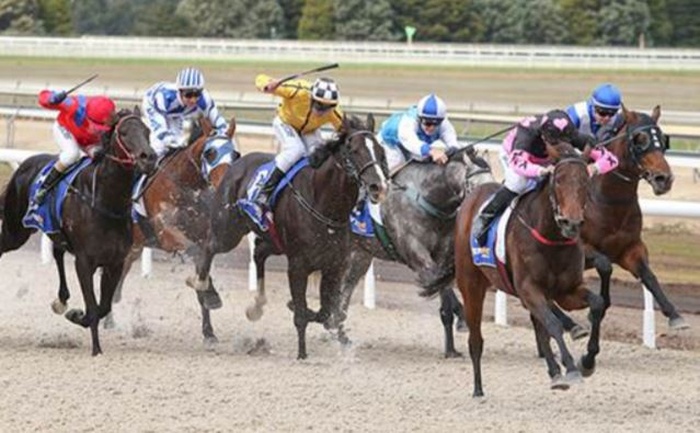There are essentially three broad types of surface for horses to race on worldwide; turf, dirt and synthetic tracks. Turf tracks are considered traditional and are still used to host the vast majority of the major races around Europe, though synthetic surfaces have gained in credibility rapidly over the past few years.
Dirt is the more traditional surface used in the USA, the ground suiting the North American style as it tends to be the fastest surface and punters there usually give more credence to the time of races, so basically it’s a case of the faster, the better for those having a bet.
Naturally, turf races are more affected by weather than those raced on dirt or synthetic tracks which gives betting customers more of a challenge to solve, though in Europe this tends to be part of the fun and often bets are won at bigger prices because of the effect of inclement weather.
In North America, the dirt tracks are considered to offer a more predictable racing pattern and therefore these are favoured with most bettors. Here we take a closer look at all three surfaces in some more detail.
Dirt

Most race courses around the Americas use natural dirt tracks as their main racing surface, something that given its natural attributes stays nice and loose and so it provides a fast running surface and suits those who like a quick pace.
Because of the prevalence of pace in America, the times of races are constantly published and are a major part of racing itself, much as they are in athletics for example with even training times known to potential gamblers.
When the rains fall these tracks of course get muddy, the going often referred to as “sloppy” and as such often suiting horses with a little more stamina instead, a more rare sight there than in Europe.
Synthetic / Artificial

The main point of courses laying an artificial surface is to allow racing to take place in bad weather, leading to less cancellations and even less racing on ‘bad’ ground which doesn’t suit the majority of runners. For this reason these tracks are usually referred to in the UK and Ireland as ‘all weather’ surfaces.
As well as the fact that these surfaces generally won’t freeze up, they tend to have better drainage too which is a major selling point to racecourse administrators who, especially in the UK and Ireland, can lose many thousands of pounds in lost meetings when the weather turns.
The UK led the way around Europe in introducing all weather racing with Southwell, Lingfield and Wolverhampton the only three on the circuit for a long time. Nowadays, a range of synthetic surfaces are used in a host of places around the globe:
| Type | Info |
|---|---|
| Cushion Track | Made by a British firm but used primarily in the USA and Scandinavia. The surface is made using a mix of sand and synthetic fibres and is coated with wax. |
| Fibresand | Again made in Britain, the mix of sand and fibres is used only at Southwell Racecourse in England. |
| Polytrack | Once more made in Britain, this one is a mixture of silica sand, fibres recycled from carpet and spandex as well as recycled rubber and PVC. This is easily the most popular artificial surface in world racing, used in a host of tracks around European and North America. |
| Pro-Ride | Made in Australia for their market of sand, nylon fibres and spandex. |
| Tapeta | An American invention but one used at Wolverhampton and Newcastle in the UK as well as a handful of tracks in the States. Dubai’s main racecourse Meydan also used this sort of track before switching to a natural dirt surface. |
The use of all weather tracks became even more popular when the Dubai World Cup, until recently the world’s richest horse race, was run on this surface as well as the Breeders’ Cup Classic being run on the dirt.
Turf

Going descriptions can vary wildly depending on the type of surface and the country in which racing is taking place. The most traditional descriptions are found in the UK and Ireland and are broken down as:
- Hard – Very rarely seen as this is often detrimental to a horse’s health, particularly its joints. Bath Racecourse in England sometimes races on ‘hard’ ground given that they are on high ground and cannot water their track. This has given Bath a niche however as a track for quick ground specialists who like it “like a road”.
- Firm – Still fairly rare, though some horses love a quick surface and have a quick action meaning they take fewer strides and glide across this sort of turf rather than land heavily on it having taken large strides.
- Good To Firm – A very common going description in the summer months and one on which many horses give their best running.
- Good – Naturally thought of as the fairest turf going, this would be the pinnacle for most clerks however it is hard to get right given the unpredictable weather in northern Europe, i.e. when the ground has been fast they may water the course only for it to rain meaning they’ll be criticised when it turns good-to-soft.
- Good To Soft (‘Yielding’ in Ireland) – Slightly rain-softened ground, leading to slower times but considered safe and fair ground for the most part.
- Soft – Avoided where possible by the typical Clerk of the Course, though a common sight across the UK, Ireland and especially France. Horses with a big, long stride tend to suit this ground as well as those with that extra touch of stamina.
- Heavy – The muddiest, most challenging and stamina-sapping ground available though once the ground reaches “heavy”, any further rain would usually lead to a postponement of the fixture.